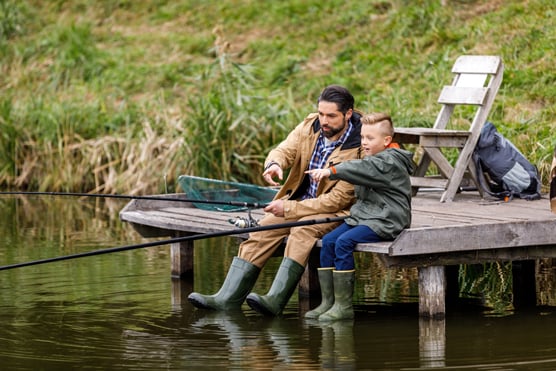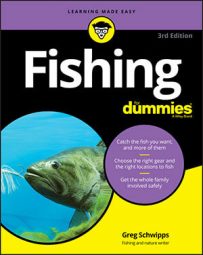 © LightField Studios / Shutterstock.com
© LightField Studios / Shutterstock.comThere are three big reasons why kids fail to get hooked on fishing:
- No one has fun! If a trip fails to generate excitement, no one involved will want to repeat the experience. Often, this means no fish were caught. Or maybe the weather ruined the trip, creating unpleasant memories.
- Kids don’t have access to a place where fishing can occur. Fishing isn’t something to be limited to one place, one time per year. But if kids don’t have a fishy habitat close to their homes, it’s hard to get too interested in it.
- Some kids don’t get to fish often, even if they are intrigued, simply because there is no one around to take them. Of all the reasons preventing kids from getting hooked on fishing, this is the saddest.
Although there are some risks — there’s no kid-friendly hook — fishing can be one of the best ways to get youngsters outdoors. What better way to interest kids in biology than to take them somewhere where they can get their feet wet? Fishing can be a kid’s gateway into the natural world and all it has to offer. (The natural world is closer to you than you think, regardless of where you live!) And it’s a great way to create funny and exciting memories. After all, in 20 years, no one wants to tell (or hear) the story about a childhood spent playing video games.
Plan (and pack) for success, not failure
Let’s face it: Some kid fishing trips are bummers because the adults set the trip up for failure. Watch the weather forecast first! If Saturday’s forecast includes a chance of thunderstorms, and Sunday looks clear, why not fish on Sunday? When kids are just starting to fish, a little patience in planning goes a long way. Make every effort to go when the weather is working for you, not against you.Pack the right clothing. Pack a change of clothes. (Then you can relax if they get the first set dirty and wet.) Throw some snacks and drinks in a cooler. Throw in more than you think they’ll need. No one has fun if they are hungry, cold, or thirsty.
Plan on assisting the kids in their fishing efforts, and don’t plan on fishing yourself. You can better help kids if your hands are free. Help form them into anglers now, so you can fish alongside them later.
Tap into bluegill mania
Bluegills are the universal “first fish.” They are widespread, found in almost every pond in America, and they happen to be willing to bite almost every day. Chances are, there’s a bluegill swimming within a 30-minute drive of where you are right now. Bluegills also school and seem to be attracted to fishing activity. Find a dock or a sunny cove and cast bits of earthworm or wax worms on small hooks. Bluegills love taking baits suspended under floats, which gives kids something to watch, and these small fish tussle quite hard when hooked. Catching one bluegill seldom spooks the others in the area, either. Just watch the sharp dorsal spines after you land them. (With practice, you can hold these spines down with the heel of your hand.)Make bait fun
Livebait fishing works for kids because it works for the fish. If fish are around, they’ll take a livebait they are used to eating.Make the act of gathering natural bait part of the adventure. Gathering worms, setting minnow traps, and catching grasshoppers or crayfish might be more enjoyable to kids than the act of fishing. Let it be.
The trick is handling the life and death issues connected to livebait. Gage your child’s reaction and respond accordingly. You might need to release one bait (where legal) for every one you use. Usually, though, kids handle this part better than we think they will. If your child is not comfortable at all with using livebait, use store-bought baits instead. Many kinds of fish can be caught on corn, shrimp, or pieces of hot dog.
Get gear that works
Fishing poles with cartoon characters work great to get kids excited about fishing, but a super short rod makes it tough to set the hook. (If you don’t believe me, try fishing with one yourself.) You want kids to actually catch fish, not just see them bite. Experiment with circle hooks, which eliminate the need to set the hook (you just hold the rod steady until the fish hooks itself). And whether you use circle or J hooks, cast sharp, small hooks that penetrate quickly. And think about replacing that short cartoon rod with one about five feet long. It’s slightly harder to handle, but it makes it easier to hook and land fish.Burn up a spinner
My kids quickly became good casters with their small spincast reels and five-foot rods. We practiced in the yard, and then went fishing with worms and bobbers. But the boys didn’t like waiting for the bobber to dip—they wanted to continue casting. They wanted to cast, and they wanted to reel … fast. The solution? I tied Worden’s Rooster Tails on their lines. Developed in the 1950s by Howard Worden, these classic in-line spinners can be cast and retrieved quickly, and the faster you reel, the more the small blade spins and flashes. Bass, crappie, and bluegill love these lures, and the fish usually hook themselves while attacking the spinner. Get a 1/16-or 1/8-ounce Rooster Tail and let your young fishing buddy start casting. (The Mepps Aglia is another fine choice.)Canoe or kayak into the local wilderness
For kids old enough to be comfortable in a small boat, there’s no better way to spend a Saturday than to paddle a quiet stretch of the local stream. Even near major metropolitan areas, small rivers and streams tend to remain wild because building is often prohibited in the floodplain. You’ll be amazed at the wildlife you can spot, and you should catch some really nice fish, too. Boredom is seldom an issue because you’re always able to paddle on down the river. You can often rent canoes or kayaks from liveries near small rivers, so check online.Chum up carp
Check your local laws, but most states allow you to chum for fish. This practice involves placing an attractant in an area to lure fish. For sharks, chum consists of blood and ground-up fish. For Common carp (not the invasive Asian carp, which are filter feeders), it involves a handful of canned sweet corn. Heat a can of corn in a saucepan over the stove, adding a bit of maple syrup and Kool-Aid (any flavor will do — but red flavors are my favorite). When you get to the lake or stream, toss a handful of corn out as far as you can. Then bait a hook with several kernels of corn and cast into the same area. Hold on! Carp come to the corn and then feed ravenously. Carp fight hard, so don’t let them pull the rod into the water! Carp can tolerate warmer water, even if it’s mildly polluted. While it’s sad that some waters are polluted, this does mean that carp are close to almost every angler in America.Try fish camping
Fishing and camping go together like football and tailgating. Too often, fishing time is defined by the trip there and the departure. Setting up camp near a likely fishing spot removes the pressure. Like Nick Adams in Hemingway's “Big Two-Hearted River,” you can relax and enjoy the fishing. For kids, a campsite means a campfire, marshmallows, flashlights, tents, and snuggly sleeping bags. Camping while fishing makes the fishing part of the adventure — not the whole adventure itself.Crank up tourney time
It’s quite possible that kids are too competitive these days. Still, catching fish naturally leads to some good-natured competition. Who caught the most fish? The biggest? I see nothing wrong with a little tournament action during an afternoon’s fishing session. After all, unlike sports such as soccer, fishing might favor the quiet, contemplative kids that care less about active sports. Fishing is a great equalizer in that way. Bass pros compete for million-dollar purses — I recommend prizes like a new tackle box or a fishing hat.Go night fishing
Night fishing is more challenging, potentially risky, and more frustrating than daytime fishing. Seems like the exact opposite of what a kid needs. True, but night fishing is also absolutely enchanting. The world, quite literally, changes. Exposing experienced kids to night fishing is like opening the door to another world.You should not attempt to take a kid night fishing until you’re an expert yourself, but being outside at night is something a kid never forgets. This might be ideal for a young person who thinks he or she is too cool or jaded for daytime bluegill fishing.

